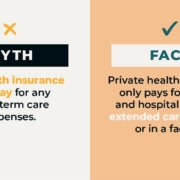Long Term Care Insurance Informal and Formal Care – Long Term Care University

Long Term Care University – Question of the Month – 09/15/10
By Aaron Skloff, AIF, CFA, MBA
Q: Some of the long term care insurance policies I am researching cover informal and formal care in my home. Can you explain what that means and what advantages it may provide?
The Problem – Home Care Coverage Limited to High Priced Licensed or Certified Providers
Most long term care insurance policies place limitations on who can provide long term care in your home. Most require the provider to be a licensed: Registered Nurse, Licensed Practical Nurse, Licensed Vocational Nurse, Physical Therapist, Occupational Therapist, Speech Therapist, Respiratory Therapist, Medical Social Worker or Registered Dietician; or a licensed or certified Home Health Aide, Nurse Aide or equivalent.
Policies that require licensed or certified home health care providers limit which providers you can utilize for your home care. Licensed or certified providers can be much more expensive than unlicensed or uncertified providers. Licensed or certified providers can drain you policy’s pool of money much quicker than unlicensed or uncertified providers.
Click Here for Your Long Term Care Insurance Quotes

The Solution – Informal Home Care Coverage
Informal Home Care Coverage. Some long term care insurance policies cover home care from licensed or certified providers and informal caregivers, such as friends or neighbors. The informal caregiver may be member of your church or temple. The informal caregiver can prepare meals, clean house, make minor safety-related repairs, take out trash, complete household chores and other services that can help you maintain a better quality of life.
Let’s look at an example of two policies with the same pool of money; one that covers both informal care and formal care and another that only covers formal care – where the informal care costs half as much as the formal care. Because informal care costs half as much as formal care the policy that covers informal care allows your benefits to last twice as long, as seen below.
| Policy Covering Only Formal Care | Policy Covering Both Informal and Formal Care |
| Pool of Money $200,000 | Pool of Money $200,000 |
| Divided by Monthly Cost of Formal Care $5,000 | Divided by Monthly Cost of Informal Care $2,500 |
| Benefits Last 3 Years, 4 Months | Benefits Last 6 Years, 8 Months |
Importance of Home Care Benefits
In a recent study conducted by one of the largest long term care insurance companies, 73% of its initial benefit claims were for home care. Nearly 70% of the people who began receiving home care under the company’s policies stayed at home throughout the time they needed care. When purchasing long term care insurance verify that the policy covers home care.
Action Step – Protect Yourself with a Policy that Covers Both Informal and Formal Home Care
When you purchase a long term care insurance policy that covers both informal and formal care you gain the flexibility to use licensed or certified providers and informal caregivers, such as friends and neighbors. In addition to a wider number of care provider choices, a policy that covers both informal and formal care can make your benefits last much longer.
Aaron Skloff, Accredited Investment Fiduciary (AIF), Chartered Financial Analyst (CFA) charter holder, Master of Business Administration (MBA), is the Chief Executive Officer of Skloff Financial Group, a NJ based Registered Investment Advisory firm. The firm specializes in financial planning and investment management services for high net worth individuals and benefits for small to middle sized companies. He can be contacted at www.skloff.com or 908-464-3060.












